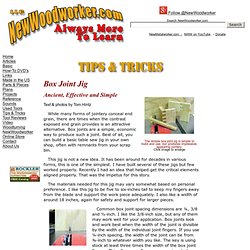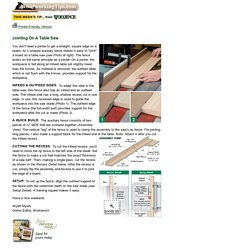

Building a Box Joint Jig - NewWoodworker.com LLC - www.newwoodworker.com (HTTP) Text & photos by Tom Hintz While many forms of jointery conceal end grain, there are times when the contrast exposed end grain provides is an attractive alternative.

Box joints are a simple, economic way to produce such a joint. Best of all, you can build a basic table saw jig in your own shop, often with remnants from your scrap bin. This jig is not a new idea. It has been around for decades in various forms, this is one of the simplest. The materials needed for this jig may vary somewhat based on personal preference. Common box joint spacing dimensions are ¼, 3/8 and ½-inch.
It is important that the dado be cutting the correct sized groove. First, cut material for the indexing pin and spacer "stick. " Table Saw Dovetail Jig. Rip-Fence Saddle. Cross-Cut Sled. Subscribe (iTunes/RSS) Then One of the first fixtures I ever made for my shop was a cross-cut sled.

Heavily-influenced by David Marks, I modeled it after his design. The sled opened up a whole world of possibilities for not only cross-cutting, but joinery as well. I didn’t have a reliable compound miter saw at the time so this versatile fixture really helped me get the most out of my limited tool set. Now Now with a full complement of tools, I am finding myself longing for some of the simple solutions I used in the past. Hip To Be Square! To square the fence, I use the “5-cut squaring method”, which you can see demonstrated in the video and also in this little Flash presentation. Important Note – I messed up! Dimensions. Woodworking Tip: Jointing On A Table Saw - www.woodworkingtips.com (HTTP)
You don't need a jointer to get a straight, square edge on a board.

An L-shaped auxiliary fence makes it easy to "joint" a board on a table saw (see Photo at right). The fence works on the same principle as a jointer. On a jointer, the workpiece is fed along an infeed table set slightly lower than the knives. As material is removed, the outfeed table, which is set flush with the knives, provides support for the workpiece. Infeed & Outfeed Sides To adapt this idea to the table saw, this fence also has an infeed and an outfeed side.
A Quick Build The auxiliary fence consists of two pieces of ¾″ MDF that are screwed together (Assembly View). Cutting the Recess To cut the infeed recess, you'll need to move the rip fence to the left side of the blade. Setup. Table Saw Jointing Jig - NewWoodworker.com LLC - www.newwoodworker.com (HTTP) Help for the jointerless Text & Photos By Tom Hintz The table saw jointing jig is actually a sled with a straight face on one side that rides against the fence and a bed on the other side to which a crooked piece of wood can be secured.

When the sled is pushed through a table saw the straight side of the jig follows the fence, moving the crooked edge through the blade in a perfectly straight line. The most popular length for this jig is 4-feet and accommodates the vast majority of pieces for our projects. Longer versions, up to 8-feet-long, are possible should your shop have those needs. This story is based on a 4'-long jig but the same construction techniques apply to longer versions with appropriate modifications to the length of the parts. Start Straight To build an accurate table saw jointing jig, start with a straight board for the main rail.
Nearly every supplier carries the 2 by 4'-long sheets of ¾"-thick plywood. Building a Rigid Bed Clamps Finishing. Finger-Joint Jig. There are countless ways to cut finger joints (also called box joints).

You can cut them by hand, with a router, or on the tablesaw. Over the years, Fine Woodworking has published plans for a variety of jigs to cut them. In issue #214, we featured another one: a dedicated tablesaw sled by Dennis Theisen of Grand Rapids, Mich. The jig is super easy to make (some can be highly-engineered like this one by Matthias Wandel) and cuts one size of fingers.
You can easily adjust it using the rear fence face to get the cut dialed in just right. Give the jig a try. <p>Either scripts and active content are not permitted to run or Adobe Flash Player version 10.0.0 or greater is not installed.